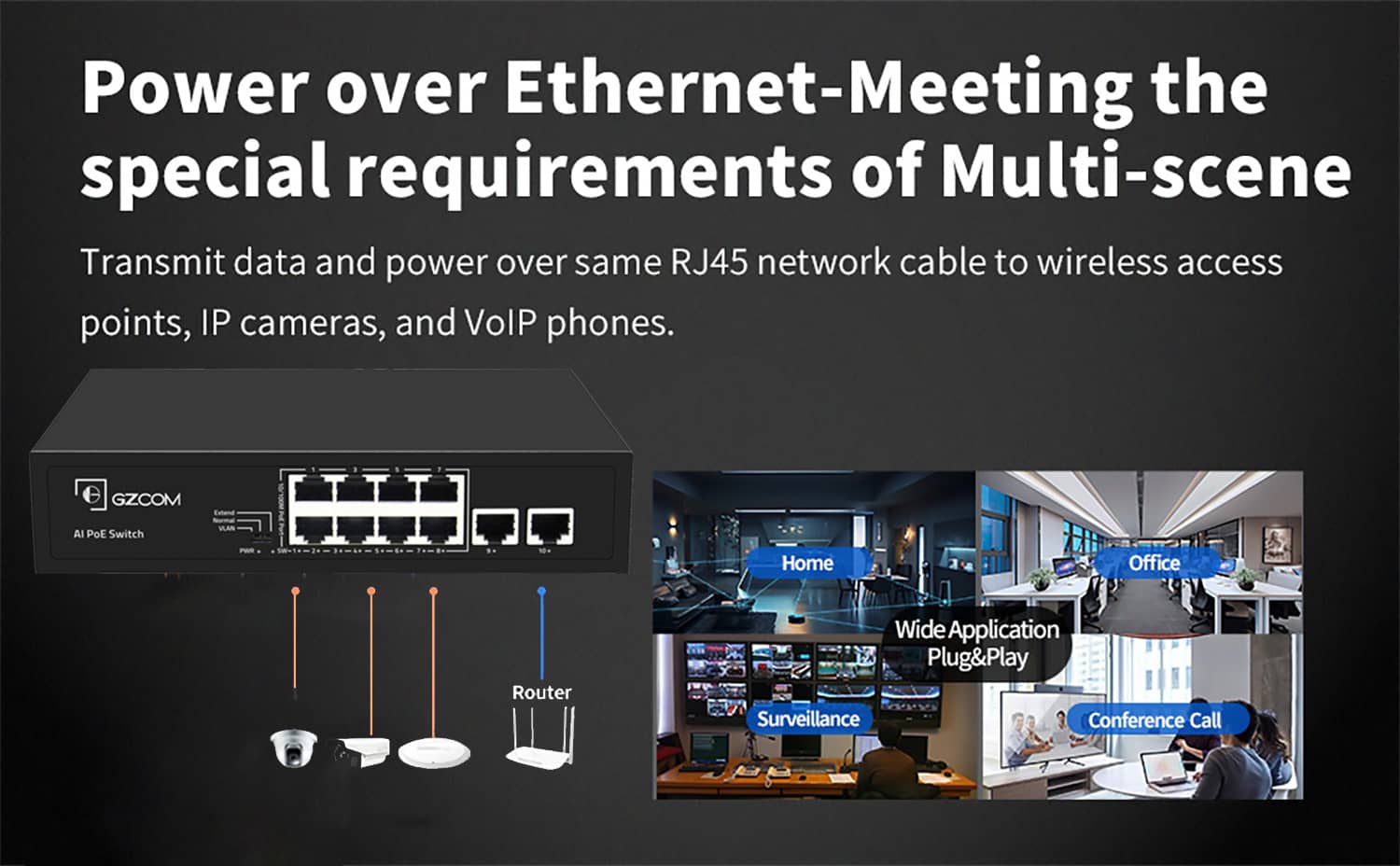Please submit your message online and we will contact you as soon as possible!
- Experience security and speed, without compromise.

2025-03-04
When setting up or upgrading a network, one of the critical decisions you'll face is choosing the right type of network switch. Specifically, understanding the difference between an 8 port PoE switch and a non-PoE switch is crucial. Both types facilitate data communication, but their capabilities and applications diverge significantly. GZCOM, a leading network solution provider, explains the distinctions to help you make the informed choice for your specific needs.
An 8 port PoE switch, or poe switch 8 port, is a network switch that incorporates Power over Ethernet (PoE) functionality across its eight ports. This means it can supply electrical power along with data over Ethernet cables to connected devices. This eliminates the need for separate power supplies for PoE-compatible devices, simplifying installations and reducing cable clutter.
Power and Data over Single Cable: Transmits both electrical power and network data through a single Ethernet cable.
Simplified Installation: Reduces the need for power outlets near devices, making installation easier and more flexible.
Centralized Power Management: Allows for centralized control and monitoring of power to connected devices.
Reliability: Often includes features like power redundancy, enhancing network reliability.
Explore GZCOM's range of 8 port PoE Switches to find models that meet your specific requirements.
A non-PoE switch, in contrast, solely focuses on data transmission. It provides network connectivity to devices but does not supply power through Ethernet cables. Connected devices require their own power adapters to operate. Non-PoE switches are simpler in design and generally less expensive than their PoE counterparts.
Data Transmission Only: Primarily for network data connectivity, without power delivery.
Requires Separate Power: Connected devices need individual power supplies.
Simpler Design: Generally has a less complex internal structure than PoE switches.
Cost-Effective: Typically lower in cost, especially for basic networking needs.
The core difference lies in power delivery. However, this fundamental distinction leads to several other significant differences that impact application and suitability.
● Power Delivery Capability

This is the most crucial difference. An 8 port PoE switch can power compatible devices directly, while a non-PoE switch cannot. This capability simplifies deployments for devices like:
IP Cameras: Powering security cameras without needing nearby power outlets.
VoIP Phones: Supplying power to Voice over IP phones, streamlining office setups.
Wireless Access Points (APs): Enabling flexible placement of APs for optimal Wi-Fi coverage.
IoT Devices: Powering various Internet of Things devices, such as sensors and controllers.
Non-PoE switches require each of these devices to have its own power source, adding complexity and cost.
● Installation and Setup
8 port PoE switches simplify installation, especially when deploying multiple PoE-powered devices. Fewer cables are required, leading to cleaner setups and reduced labor costs. You can position PoE devices more freely, as power outlet proximity is not a constraint.
Non-PoE switches involve more complex setups in PoE device deployments, demanding separate power cabling and potentially requiring electricians for power outlet installations.
● Cost Considerations
Initially, 8 port PoE switches typically have a higher upfront cost than non-PoE switches. However, the total cost of ownership can be lower for PoE solutions in the long run. Consider savings from:
Reduced cabling and installation labor.
Eliminated need for individual power supplies and outlets.
Centralized power management, potentially leading to energy savings and easier maintenance.
For small networks or where PoE is not needed, non-PoE switches are more economical in terms of initial investment.
● Scalability and Flexibility
8 port PoE switches offer greater scalability and flexibility for networks that might expand to include PoE devices in the future. Investing in a PoE infrastructure upfront can be more future-proof, saving costs and effort on upgrades later.
Non-PoE switches lack this future-proof flexibility. Upgrading a non-PoE network to accommodate PoE devices later can be more disruptive and costly, often requiring complete switch replacements and new power infrastructure.
● Application Scenarios
The application dictates the better choice. 8 port PoE switches are ideal for:
Security systems with IP cameras.
VoIP phone systems in offices.
Wireless networks with multiple access points.
Smart buildings and IoT deployments.
Non-PoE switches are suitable for basic data networking needs where power delivery is not required, such as:
Home networks for internet access and file sharing.
Small offices without PoE devices.
Network segments dedicated solely to computers and printers.
Select an 8 port PoE switch when:
You need to power PoE-compatible devices like IP cameras, VoIP phones, or wireless APs.
Simplified installation and reduced cabling are priorities.
Centralized power management is beneficial for your network.
Future network expansion may include more PoE devices.
Opt for a non-PoE switch when:
Your network only needs to connect devices that are not PoE-compatible, such as computers, printers, and servers with their own power sources.
Cost is the primary concern, and you need to minimize initial investment.
Power delivery over Ethernet is not a requirement for your current and foreseeable network devices.
Choosing between an 8 port PoE switch and a non-PoE switch depends heavily on your network requirements. For networks incorporating PoE-powered devices, an 8 port PoE switch offers significant advantages in simplification, cost-effectiveness over time, and future scalability. For basic data networking without PoE needs, a non-PoE switch can be a more budget-friendly option initially.
Please submit your message online and we will contact you as soon as possible!